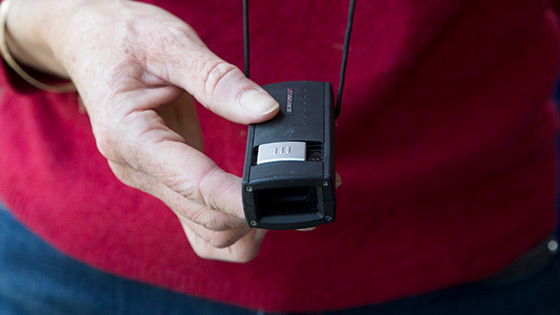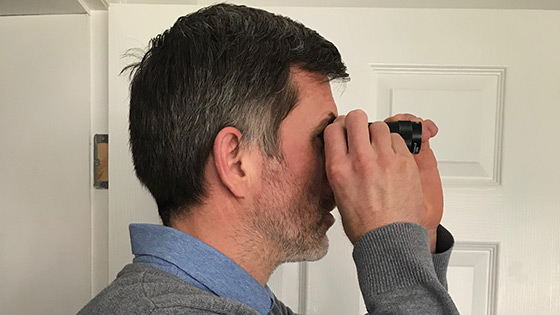How to view things in the distance
If you have a vision impairment it may be more difficult for you to view things in the distance and to see people who are approaching you. One solution could be to use a low vision aid, for example, a handheld monocular, binoculars or a smart phone or tablet.
On this page
Monoculars and binoculars
Both a monocular and binoculars are typically used to view things in the distance, such as street signs, bus numbers, shop signs, train displays, sporting events, theatre performances, and aisle information in shops. They can also be used to find and avoid people when you’re out and about.
The magnification levels are usually measured and described with two numbers, for example: 6x16 – with the first number being the level of magnification (6x) and the second being the diameter of the lens at the front (16mm).
Using a monocular or binoculars takes practise and we usually recommend that you have an assessment from a low vision specialist at your Low Vision Clinic, where you can talk through the options and a monocular or binoculars may be issued. Professionals such as a Rehabilitation Worker for adults, or a Habilitation Specialist or Teacher of students with Visual Impairments (TVI) for children and young people would ordinarily offer face-to-face support and training to use these aids.
While most face-to-face support and training is currently on hold, some organisations may be able to offer this service remotely. To find your local support network or for further information about support and training please visit the Sightline Directory.
Alternatively, you may have something around the house that you could use, such as a pair of binoculars. It’s worth noting that there are monoculars and binoculars that can be mounted onto a pair of spectacles, but these should only be used when sitting still, and not for mobility purposes.
If you already know which monocular or binoculars you need, you can purchase them from specialists such as Optima Low Vision Services. Please visit their website or contact them by telephone on 01803 864218 for more information. If you are getting an item posted to you, please follow the guidelines around cleaning/disinfecting items before use.
Handheld monocular (referred to simply as ‘a monocular’)
A monocular is a small telescope that typically ranges in power from 4x to 14x magnification. Put simply, a monocular is one half of a pair of binoculars. A close-focusing monocular can be used to view things in the distance or up close and can aid in viewing items without touching them.
Benefits
They are small, compact and can usually fit into your pocket or bag. They are discrete and with practise you can focus them with one hand.
Drawback
They have a small area to view through.
Using a monocular
We would recommend that you always stand still when viewing things through a monocular. If you wear glasses, keep them on, unless otherwise advised not too.
When practising:
- First, use your residual vision to look in the general direction of an object or landmark you want to view, then hold your gaze there.
- Next, bring the rubber end of monocular up in front of your eye and get it as close as possible without touching your eye. If you have residual vision in both eyes, then try using the eye with best vision. If this doesn’t feel natural, use the other eye.
- If you wear glasses fold over the rubber end and place the monocular on your glasses.
- Hold the far end (furthest from your eye), which is often ridged, with your other hand and turn it until the object/landmark becomes clear. If it doesn’t come into focus, turn it back in the other direction. Continue doing this until the object/landmark comes into view.
- Once you have mastered bringing the monocular up, focusing it and viewing something, then practise viewing things at different distances.
- Once you have mastered holding, focusing and viewing things at different distances there are some other strategies you can try.


Binoculars
Benefits
Binoculars have a larger field of view as there are two lenses to view through. If you have useful vision in both eyes, binoculars should help you see more of the area at one time than a monocular.
Drawbacks
They are larger, often heavier and more obvious than a monocular. Some people may want to be discreet and not be seen using a low vision aid, and therefore a monocular can be used discreetly whereas using binoculars may be more obvious.
Using binoculars
We would recommend that you always stand still when viewing things through binoculars. If you wear glasses, keep them on (unless otherwise advised not too).
- First, use your residual vision to look in the general direction of an object or landmark you want to view, then hold your gaze there.
- Next bring the rubber ends of binoculars up in front of your eye and get it as close as possible without touching your eyes. If you have residual vision in both eyes, then try using the eye with best vision. If this doesn’t feel natural, use the other eye.
- If you wear glasses fold over the rubber ends and place the binoculars on your glasses.
- There should be a wheel in the centre of the binoculars. Locate this with one finger and adjust it until the target becomes clear. If it doesn’t come into focus, turn it back in the other direction. Continue doing this until the target comes into view.
- Once you have mastered bringing the binoculars up, focusing it and viewing something, then practise viewing things at different distances.
- Once you have mastered holding, focusing and viewing things at different distances there are some other strategies you can try.
Other monocular and binocular techniques
- Tracing along a line or something predictable in the environment to find things.
- One way of locating/finding a landmark or target is to trace along something that you know or can view more easily. For example, following the edge of a wall to find a bus stop at the end or the line of shop signs or kerb edge to find a gap etc.
- You could also use this technique in a supermarket to view signage or to check if an area is empty.
Tracking something that is moving, for example, a person, bus or car
- One way of finding and tracking something that is moving is by finding a landmark that you know or think the moving object will pass. For example, find and stay focused on a tree that a person will walk past or street sign that a bus will pass by.
- Once the moving object comes and into view at the landmark, follow it by moving the monocular or binocular in the direction it is going.
- This can be particularly good if there is an area where people walk past and you are unsure if they will move towards or away from you, for example at a junction or entrance to a shop.
Scanning systematically to find things
- Start at a point near you and move the monocular or binoculars and your head in sync. If you are searching for something horizontal, such as a street sign you could try scanning vertically/up and down systematically, gradually moving from your left to right (as you will be more likely to find part of the long object, in this case a sign, when scanning vertically/up and down). If you are searching for something vertical for example a pillar at the entrance to a park where you know people walk their dogs or bus stop where you know people could be waiting, you should scan horizontally/from left to right, starting low, near you and gradually moving up and away from you.
- Once you have found the item you can then move up it, for example, you may find the bottom part of the pillar or bus stop, and need to move up so you are more likely to view the people. If you see any people you can decide to wait until they pass or perhaps take another route.
Using smart phones or tablets
You can use a smart phone or tablet as a distance aid and apply strategies such as ‘tracking’ something that is moving, ‘tracing along a line’ or something predictable in the environment to find things and ‘Scanning systematically’ to find things (see above). For more detailed information on how to use your smartphone please visit our viewing or reading nearby objects guidance.